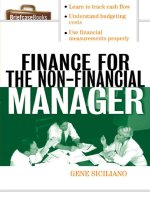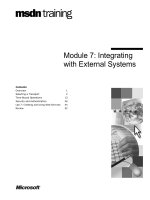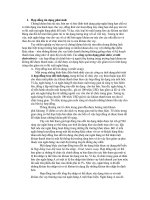Tài liệu HEDGING BOND RISK WITH INVERSE ETFs pdf
Bạn đang xem bản rút gọn của tài liệu. Xem và tải ngay bản đầy đủ của tài liệu tại đây (349.19 KB, 4 trang )
Your Bond Portfolio May Be At Risk
Over the last decade, investors increasingly have been drawn to bonds.
Bonds are often viewed as a critical component of a diversified asset
allocation strategy, potentially providing a steady income stream and
stability to a portfolio.
Bonds have performed well over the past 30 years. The 10-year U.S.
Treasury Bond returned approximately 9.5% annually from 1981 to
2011—outperforming the S&P 500’s annualized return of 7.4%. But
bond prices don’t always go up.
Rates Up, Bonds Down
Bond prices and yields generally move opposite each other. As shown
above, bond yields fell to historically low levels as bond prices climbed.
Recently, experts have been raising concerns about the sustainability of
low interest rates. If rates increase, bond yields are likely to rise, triggering
potentially significant losses in bond portfolios.
Hedging Bond Risk
with Inverse ETFs
Bond investors may
be exposed to more
risk than they realize.
They may not know
what to do about it.
Here we discuss a
strategy that may
help cushion a bond
portfolio if rising
rates drive down
bond prices.
STRATEGY INSIGHTS
What’s Next for Bonds?
Source: Bloomberg. Bond returns calculated using monthly Federal Reserve Board data from 12/31/80 to 12/31/84 and Merrill
Lynch 7-10 Year U.S. Treasury Index from 1/31/85 to 12/31/11. For illustrative purposes only. Past performance does not
guarantee future results.
0%
4%
8%
12%
16%
0%
400%
800%
1200%
1600%
10-Year U.S. Treasury
Bond Yield
Yields fell from a high of 15.8%
in 1981 to 1.9% in 2011
Average Annual
Total Return = 9.5%
Dec-80 Dec-85 Dec-90 Dec-95 Dec-00 Dec-05 Dec-10
Yields
Returns
2 :: proshares.com
An increase in interest rates will generally drive
down the price of a bond. To quantify the potential
impact of rising rates on your portfolio, it is helpful
to look at duration.
Duration reveals the sensitivity of the value of a bond
(or bond portfolio) to a change in interest rates and
the yields of securities with similar characteristics.
Higher duration means greater sensitivity. For
example, the 30-year U.S. Treasury Bond with a
duration of 19 will be about twice as sensitive to a
change in yield as the 10-year U.S. Treasury Bond,
which has a duration of 9. So, a 1% rise in the yield of
the 30-year U.S. Treasury Bond could cause its value
to decline by approximately 19%, whereas a similar
increase in the yield of the 10-year U.S. Treasury Bond
would cause a decline of about 9% in its value.
How sensitive might your portfolio be to changes in
yields? The table below shows what could happen
to the value of bond portfolios of varied durations
given a range of changes in yields, all other things
being equal.
Consider a $100,000 bond portfolio with a duration
of 6.0. Just a 1% rise in the yield could cause the
value of the portfolio to decline by 6% to $94,000—
possibly offsetting two years’ worth of interest
income. A 2% increase in yield could drive the
value down to $88,000. Of course, bonds and bond
portfolios can be negatively or positively influenced
by other factors as well.
1
Measuring the Impact
Even a small shift in yields could
trigger a substantial change in the
value of your bond portfolio.
How to Prepare
Duration and interest rate direction may not be a significant concern if you hold individual bonds and
plan to keep them until maturity. However, if you invest in bond mutual funds or there’s a chance you
might need to liquidate your bond holdings prior to maturity, you may want to manage interest rate
risk. Generally, there are two approaches to consider in preparing for a rising-rate environment.
• Restructuringyourportfolio. Commonly used strategies include: reallocating fixed-
income holdings to other asset classes; investing in fixed-income vehicles with shorter
maturities; and shifting to less rate-sensitive bonds.
This approach may mitigate the risk of interest rate movements but will require some
fundamental changes to your portfolio’s core strategy. Selling bonds also could trigger tax
consequences and affect the income stream from your investments.
• Hedgingyourbondportfolio. Many investors choose to implement a hedge—a more tactical
approach to managing interest rate risk—instead of or in addition to restructuring.
$100,000 Bond Portfolio with a Duration of …
Change
in Yield 4.0 5.0 6.0 7.0 8.0 9.0 10.0
+2%
-$8,000 -$10,000 -$12,000 -$14,000 -$16,000 -$18,000 -$20,000
+1%
-$4,000 -$5,000 -$6,000 -$7,000 -$8,000 -$9,000 -$10,000
-1%
$4,000 $5,000 $6,000 $7,000 $8,000 $9,000 $10,000
-2%
$8,000 $10,000 $12,000 $14,000 $16,000 $18,000 $20,000
Source: McGraw-Hill Financial Communications. Values are approximate; there is no guarantee the actual changes in portfolio values would equal amounts
shown here. In addition, larger rate increases will likely result in smaller changes in value than indicated by duration, as duration is accurate only for small
changes in yields.
1
Bonds and bond portfolios can also be influenced by credit risk, reinvestment risk, inflation risk, prepayment risk and liquidity risk.
proshares.com :: 3
A hedge is an investment that aims to move in the opposite direction to the asset considered at risk. A bond
hedge can decrease your exposure to interest rate changes by moving counter to bond prices. When bond
prices decline, the value of your hedge should increase, partially offsetting the loss in your portfolio. Of course,
if bond prices rise, employing a hedge would entail sacrificing some return. Hedges also have risks and are not
suitable for all investors. Ways you can hedge your bond portfolio include:
• Short-selling.Short-selling an investment that has interest rate exposure, like a bond ETF, provides
a hedge against rising rates. But short-selling may involve opening a margin, options or futures
account and maintaining a certain level of assets in the account. In addition, there is a risk you could
lose more than you invested.
• BuyinganinversebondETF. Inverse bond ETFs are designed to move opposite fixed-income
benchmarks, such as a Treasury bond index. They typically seek returns that are the inverse (e.g., -1x
or -2x) of the one-day return of the benchmark. ETFs are easily accessible—they trade like stocks on
major exchanges—and you can’t lose more money than you invest. It’s important to note that inverse
bond ETFs require careful monitoring and may need frequent rebalancing. This entails certain costs
and may have tax consequences and result in lower performance.
Hedging Your Bond Portfolio
Hedging with an Inverse Bond ETF
On the right is a simple illustration of the effect of a hedge on
a portfolio. It shows a $100,000 bond portfolio that is hedged
with a $10,000 investment in an inverse bond ETF. The hedge
offsets certain risks in 10% of the portfolio, while 90% remains
fully at risk.
To quantify the impact of this hedge, let’s go back to the
concept of duration. Below we show what happens to the
portfolio, which has a duration of 6.0, when the hedge is added.
The addition of the inverse bond ETF, which acts as if it has a
duration of -7.6 (the underlying index has a duration of 7.6),
would make the combined portfolio act as if it had a lower, less
rate-sensitive duration of 4.8.
$100,000 Bond Portfolio
Duration of 6.0
-1x ETF acts as if it
has duration of -7.6
Acts as if it has
duration of 4.8
Combined Portfolio
$100,000 Bond Portfolio
What does this do to performance? As illustrated in the table on page 2, a 1% rise in yield could cause a
$100,000 bond portfolio with a duration of 6.0 to incur losses of $6,000. If the hedge shown in the example
above were added to the portfolio, however, losses could be reduced to $4,800.
$90,000 At Risk
$10,000 -1x ETF
$10,000 -1x ETF
$10,000 -1x ETF
This example is hypothetical and there can be no guarantee an actual investment product or strategy will perform as shown.
Benefits and Risks of Inverse Bond ETFs
Using inverse bond ETFs to hedge interest rate risk is an approach that can
complement and enhance longer-term strategic moves. This approach:
• Helps keep your asset allocation in line with your long-term investment goals
• Helps preserve your portfolio’s income stream, and
• May not trigger a taxable event from selling appreciated bonds, as long as
you have cash on hand to purchase the ETF and rebalance when necessary
• Offers flexibility—ETFs can be applied and removed as needed without
disturbing your core strategy
• Unlike short-selling, does not require opening a margin, options or futures
account and maintaining a certain level of assets in the account, and
• Limits any potential losses to the amount invested
Inverse ETFs have one-day return objectives. Therefore, careful monitoring
is essential. Rebalancing may be necessary for periods longer than one day
because the effects of compounding can cause the return of an inverse ETF to be
greater than or less than the index return times the fund multiple. Sometimes
the difference can be significant. Note that a rebalancing strategy may result in
transaction costs and tax consequences.
Investing in inverse ETFs is not for everyone. You should work with your financial
professional to learn more about the risks and benefits of inverse ETFs, and to
determine the appropriateness of this strategy for your investment objectives. For
more information, please visit ProShares.com and look for our educational guides
Geared Investing and Geared Fund Performance.
ProShares ETFs seek returns that are 3x, 2x, -1x, -2x or -3x the return of an index or other benchmark
(target) for a single day, as measured from one NAV calculation to the next. Due to the compounding of
daily returns, ProShares’ returns over periods other than one day will likely differ in amount and possibly
direction from the target return for the same period. These effects may be more pronounced in funds
with larger or inverse multiples and in funds with volatile benchmarks. Investors should monitor their
ProShares holdings consistent with their strategies, as frequently as daily. For more on correlation,
leverage and other risks, please read the prospectus.
Carefully consider the investment objectives, risks, charges and expenses of ProShares before
investing. This and other information can be found in their summary and full prospectuses. Read them
carefully before investing. Obtain them from your financial adviser or broker/dealer representative
or visit ProShares.com. There is no guarantee any ProShares ETF will achieve its investment objective.
ProShares are distributed by SEI Investments Distribution Co., which is not affiliated with the funds’
advisor. © 2012 PSA 2012-621
About ProShares
ProShares is a premier
provider of alternative
Exchange Traded Funds
(“ETFs”). ProShares
introduced the first geared
(leveraged and inverse)
ETFs in the United States in
2006. Today, the firm offers
over 130 alternative ETFs.
Investing involves risk,
including the possible loss
of principal. ProShares are
non-diversified and entail
certain risks, including
risk associated with the
use of derivatives (swap
agreements, futures
contracts and similar
instruments), imperfect
benchmark correlation,
leverage and market price
variance, all of which can
increase volatility and
decrease performance.
Bonds will decrease in value
as interest rates rise.
ProShares offers a variety of inverse bond ETFs that can be
valuable tools to help investors hedge against possible declines
in the bond market.
To learn more, consult your financial professional, visit
ProShares.com or call ProShares at 866.776.5125.









